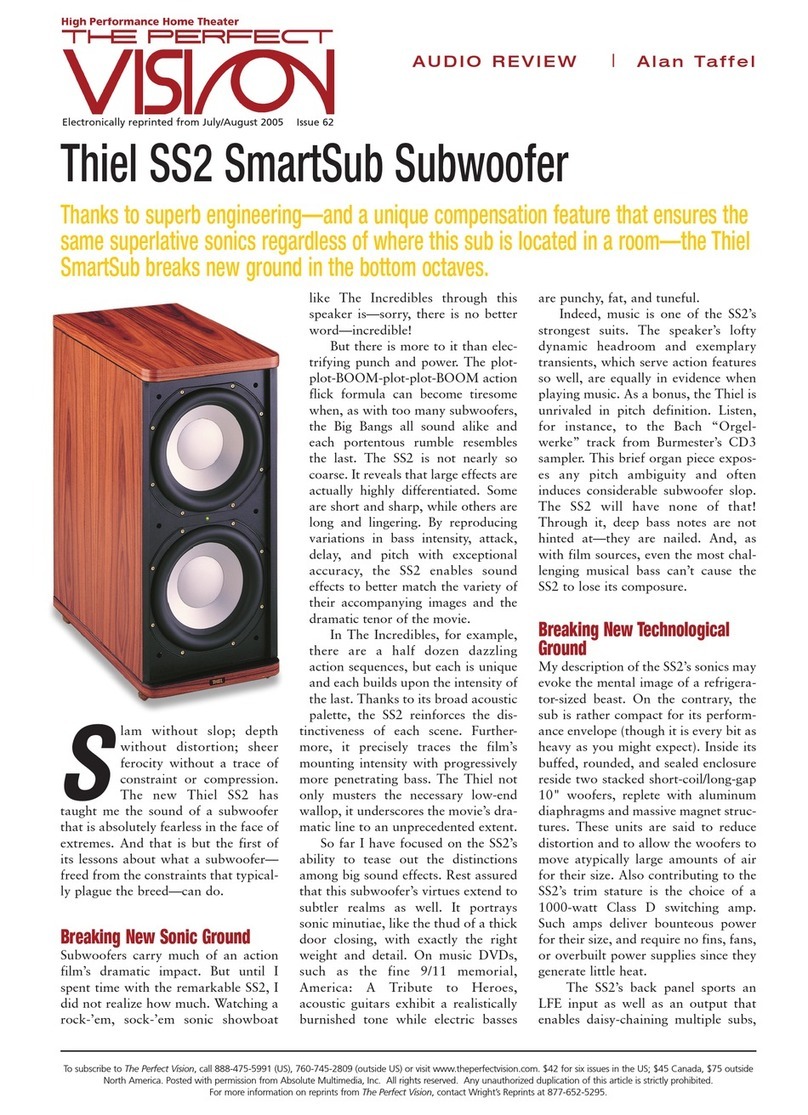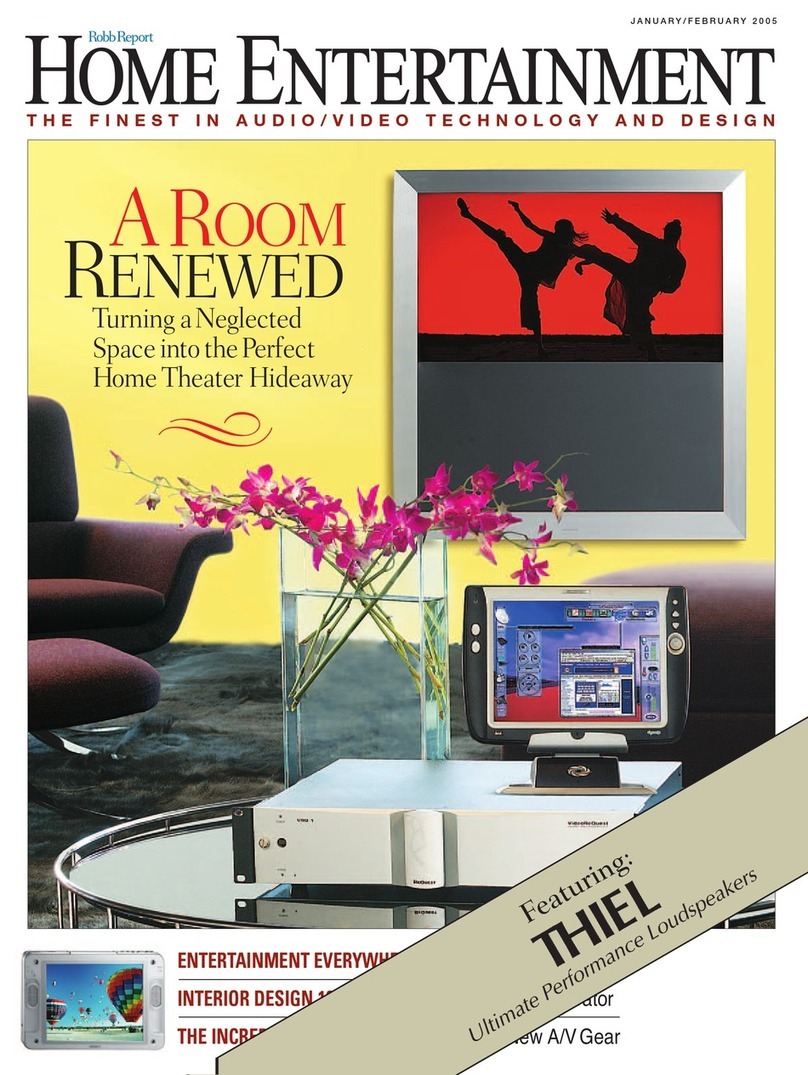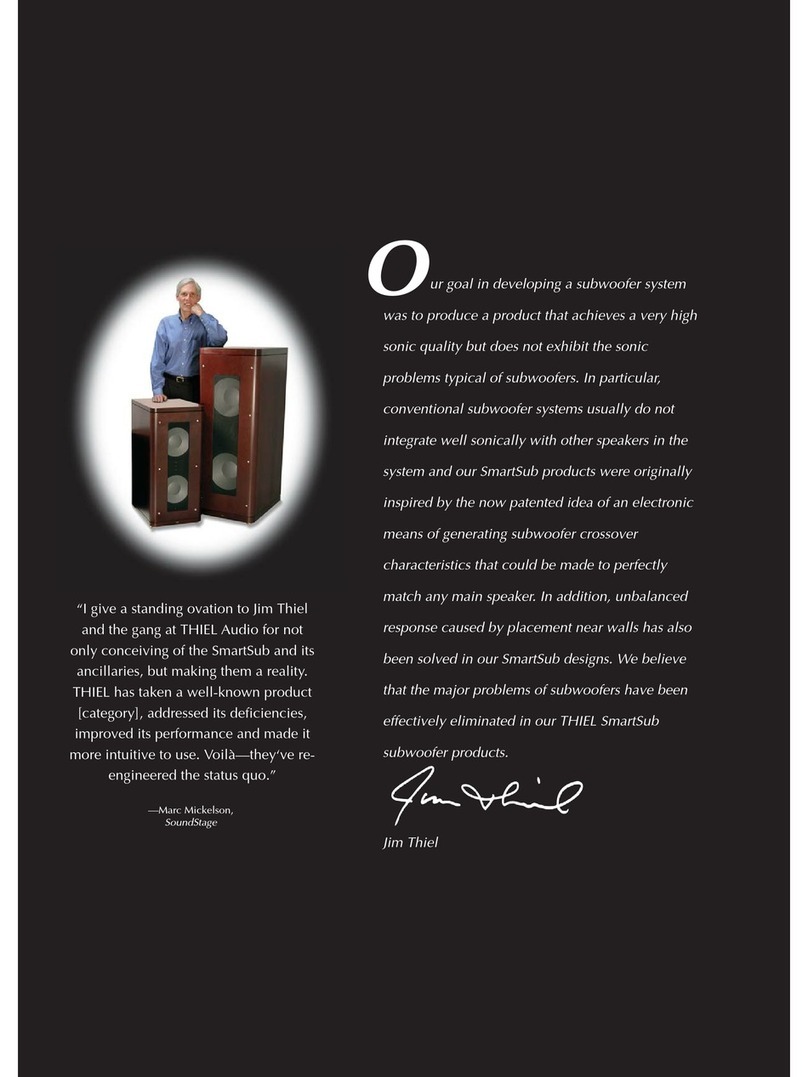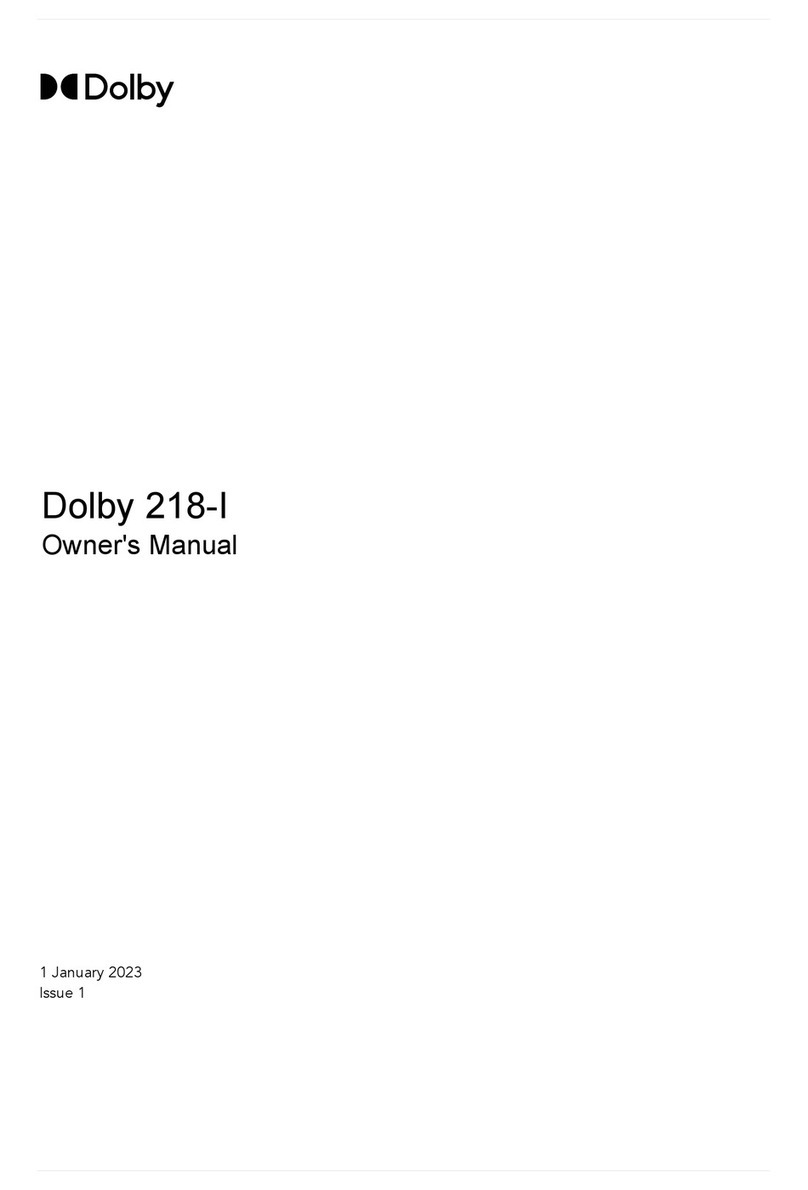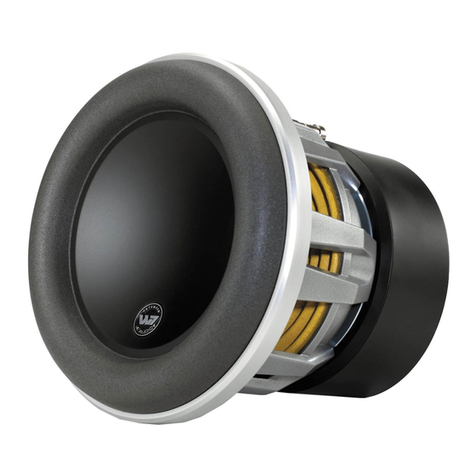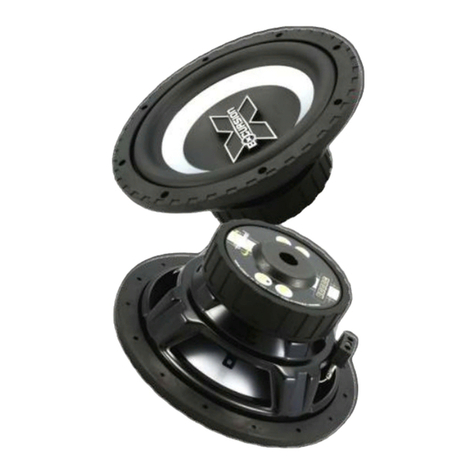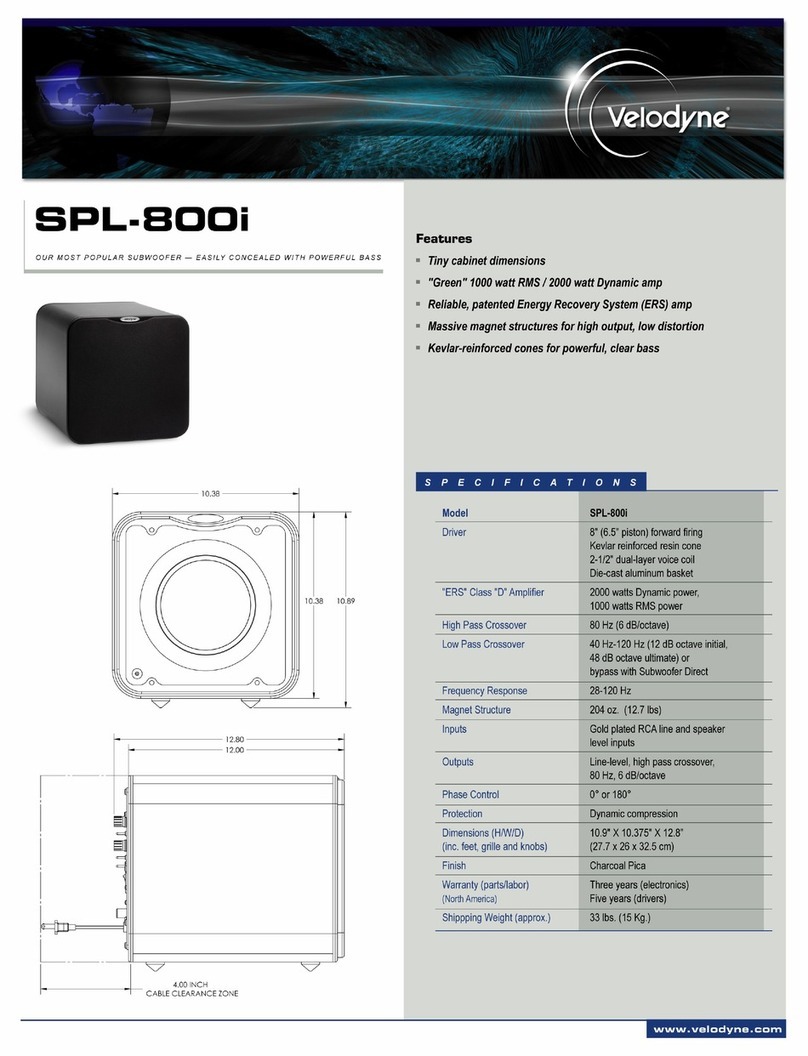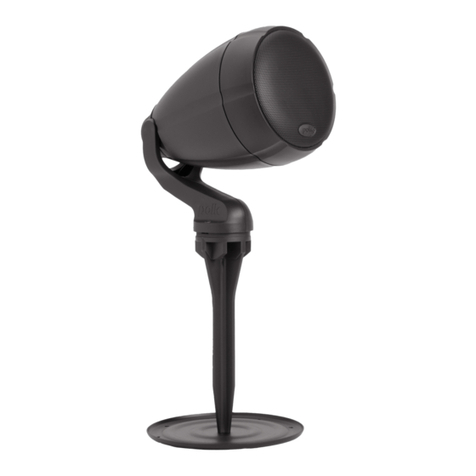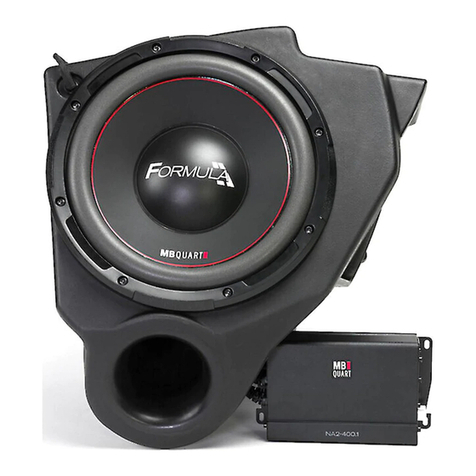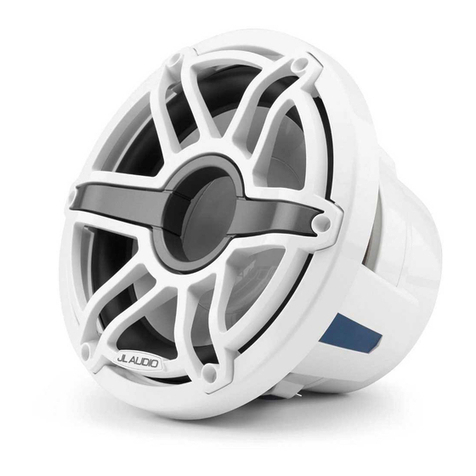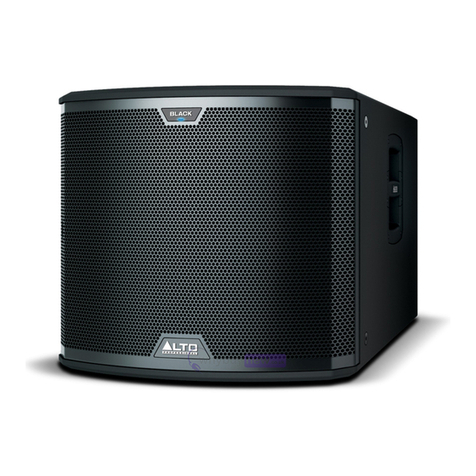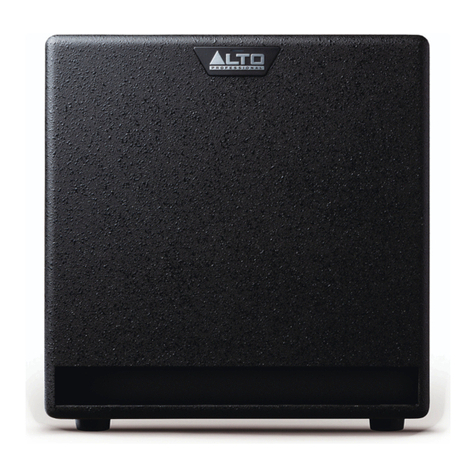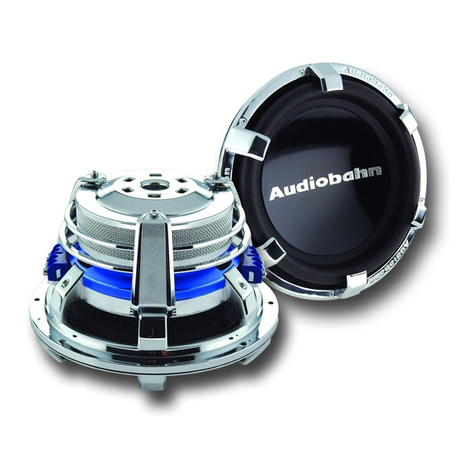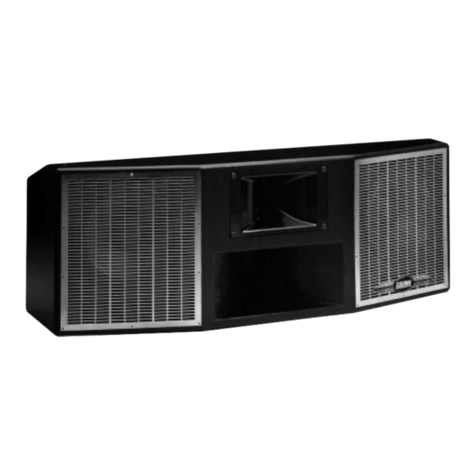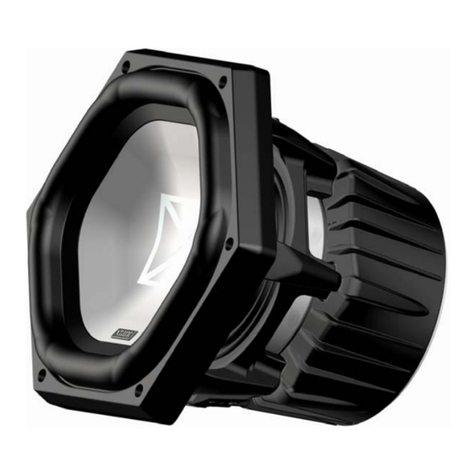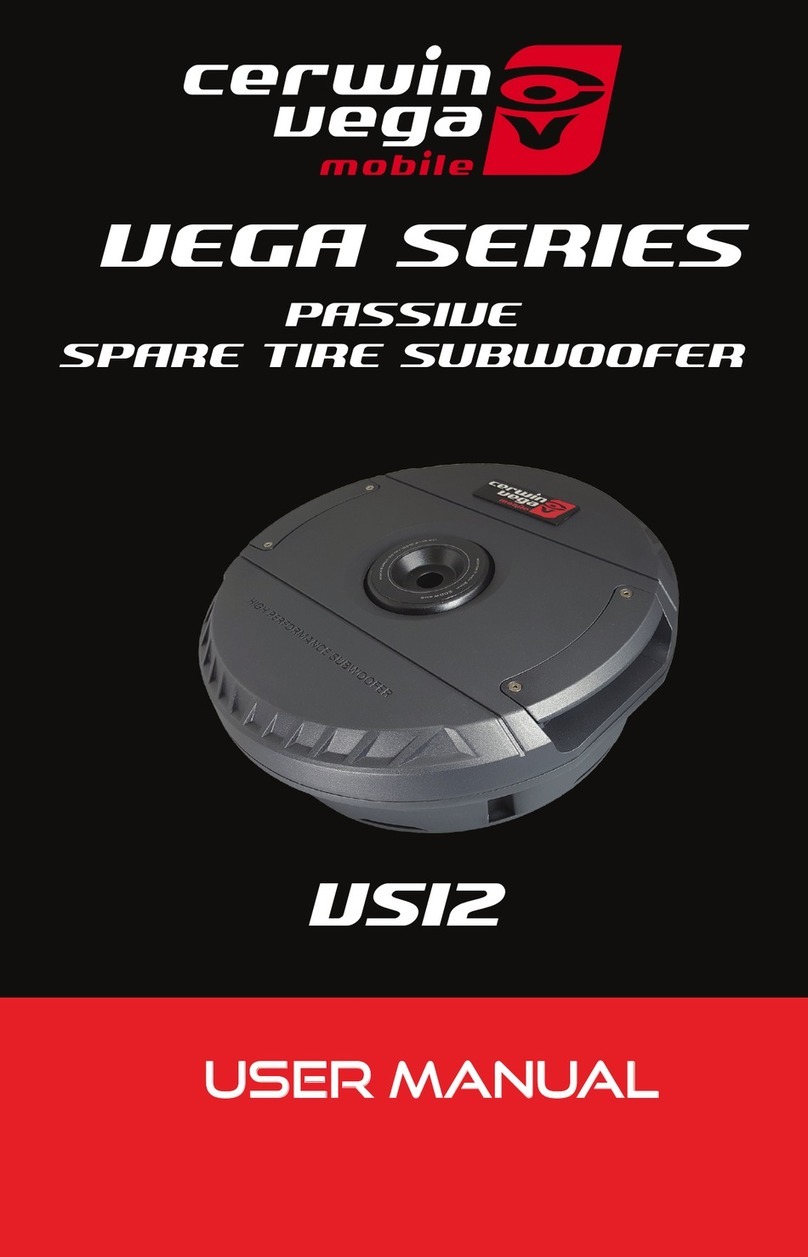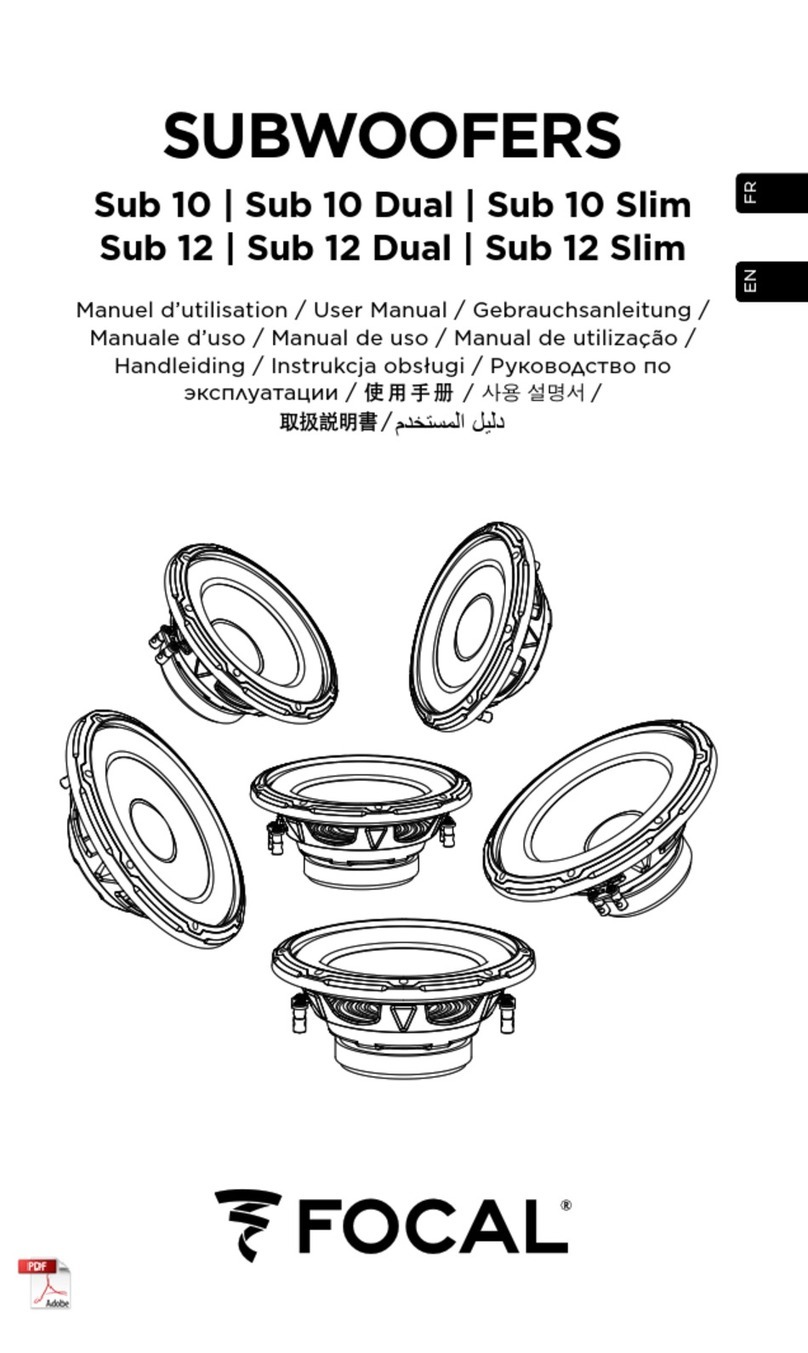Thiel USS SmartSub Technical manual

THIEL
USS SmartSub®
Owner Information
Contents
Product Features . . . . . . . . . . . . . . . . . . . . . . . . . . . 2
System Congurations. . . . . . . . . . . . . . . . . . . . . . . .3
Crossover Use . . . . . . . . . . . . . . . . . . . . . . . . . . .4
Do you require a crossover? . . . . . . . . . . . . . . . . . . . 4
Processor Bass Management . . . . . . . . . . . . . . . . . . . 4
THIEL Passive Crossovers . . . . . . . . . . . . . . . . . . . . 4
Subwoofer Placement . . . . . . . . . . . . . . . . . . . . . . . . 5
Setting up the Subwoofer . . . . . . . . . . . . . . . . . . . . . 6
Hookup . . . . . . . . . . . . . . . . . . . . . . . . . . . . . . 6
Setting the Surround Processor . . . . . . . . . . . . . . . . . . 6
Control Settings . . . . . . . . . . . . . . . . . . . . . . . . . .6
Auto shutdown . . . . . . . . . . . . . . . . . . . . . . . . . . 6
Feet . . . . . . . . . . . . . . . . . . . . . . . . . . . . . . . . 6
SmartSub Back Panel Detail. . . . . . . . . . . . . . . . . . . . .7
Fuse Replacement . . . . . . . . . . . . . . . . . . . . . . . . . . 8
Specications . . . . . . . . . . . . . . . . . . . . . . . . . . . . 8
Warranty . . . . . . . . . . . . . . . . . . . . . . . . . . . . . . . 8
Thank you for purchasing a THIEL SmartSub system. It has been
engineered to provide a very high level of performance and also
incorporates innovative and patented concepts in its design to
solve the several special problems subwoofer systems usually
exhibit. Consequently, it performs at a very high level with a
wide variety of speakers and room locations.
Jim Thiel, Product Designer
THIEL Loudspeakers

The THIEL USS SmartSub is a very high performance,
innovative subwoofer system that provides exceptionally
deep, uniform, dynamic and low distortion bass reproduction.
In addition, it provides near-ideal performance with any
room placement. These performance abilities are the result of
new patented technology developed to overcome the major
problems that subwoofers typically exhibit: poor integration
with the main speakers and altered response due to nearby
walls.
These subwoofers can be used as stand-alone units and/or with
a THIEL passive crossover depending on your requirements.
Here is a brief description of some of the unusual performance
features these subwoofer systems provide.
Very High Output, Very Low Distortion Woofer
The USS uses a very
high output, very
low distortion 10”
driver that utilizes
an aluminum
diaphragm, heavy
cast chassis and
THIEL’s short coil/
long gap, copper
stabilized motor
system powered
by a 10 lb magnet
in a structure with a
total weight of 20 lbs.
The short coil/long gap design results in very low distortion
levels that are only one-tenth that of typical drivers with
the same excursion rating. This magnet system’s very long
magnetic gap, along with the very high excursion suspension,
allows the driver to move a very large amount of air – much
more than most drivers its size – in order to effortlessly
reproduce even demanding sources at high volume levels.
550 Watt Amplifier
The USS is powered by an innovative high efciency 550 watt
RMS amplier. The amplier’s very high power ensures that
the woofer can provide all the output it is capable of without
power compression or limiting.
Placement Correction
Placement controls (patented) match the subwoofer’s
performance to its environment, whether away from walls, in a
corner or anything in-between. These controls correct for both
the general increase in level and for the partial cancellation
of certain frequencies caused by a nearby wall. By providing
correction of these effects for both the side and rear walls,
SmartSubs provide accurately balanced, uniform response with
virtually any room placement.
Thermal Management System
An automatic shutdown feature is included that protects the
driver from excessive heat produced by input levels that are
excessively high. A shutdown is automatically executed if the
temperature reaches a dangerous level and is automatically
restarted when the temperature falls to a safe level.
The USS electronics contains patented circuitry that corrects
for compression distortion due to heating of the driver voice
coil. Without this correction, subwoofer output levels could
decrease by as much as 5dB and the response altered at
times of high demand. The correction allows the subwoofer
to provide more accurate, uncompressed and dynamic
reproduction.
Accurate Matching to Main Speakers
Rather than providing generic built-in crossover controls that
can rarely achieve high quality blending of the subwoofer
with main speakers,
the SmartSub can be
used when needed
with a separate
unit - a dedicated
THIEL PXO5 passive
crossover.
The passive crossovers provide perfectly blended augmentation
of THIEL main speakers, allowing the combination to
provide very accurate
reproduction of the
entire sonic spectrum to
below the audible range.
The USS can also be
connected to an audio
system with an LFE or
other active crossover
output for use in a home
theater or with non-THIEL main speaker systems.
Product Features
USS 10” Subwoofer Driver
Heat sensor on voice coil
PXO5 Passive Crossover
2

3
Option 1. As a Stand-Alone Unit
If your main speakers play sufciently loudly for all your uses
and they reproduce the bass with satisfying completeness,
then the subwoofer is only needed to reproduce the LFE (low
frequency effects, or subwoofer) “point one” channel, and it
can be used in the LFE conguration without a crossover.
If your main speakers play sufciently loudly for all your
uses but do not reproduce the full low frequency range of
the left/right channels, you should also use the subwoofer to
augment the bass response of your main speakers. This can be
accomplished without altering the signal or wiring to your main
speakers by using one of the next two congurations.
Option 2. With a SmartSub Passive Crossover
A THIEL PXO5 passive crossover can be used if one is
available to match your main THIEL speakers and if low
frequency adjustments are not desired or required.
System Configurations
It is important to note that, unlike most home audio subwoofers, THIEL SmartSubs do not contain crossover systems, therefore
they must be used in conjuction with external crossover units to operate properly. When used in conjunction with a THIEL PXO5
Passive Crossover, near-perfect bass integration is acheived. Generic crossovers both outboard and contained within most home
theater processors may also be used to varying degrees of effectiveness.
The SmartSubs can be used in four ways depending on your requirements:
1. As a stand-alone unit dedicated solely to reproduction of LFE “point one” channel information
2. With a THIEL PXO5 passive crossover
3. With a combination of passive crossover and LFE connection in a home theater application
4. In true crossover mode reproducing low frequency information redirected to it by an external active crossover
The conguration chosen will determine your required equipment, hookup connections and processor settings. Which system
conguration is best for you depends mainly on the capabilities of your main left/right speakers.
Additional discussion of these options can be found in the section Crossover Use. In addition, there is a comprehensive ow chart
for your reference on pages 12 and 13 that guides you through all aspects of system conguration, hookup, and adjustment.
LEFT RIGHTCENTER L REAR RREAR
SUB
RightBalInput
LeftBalInput
L+ L– R–R+
INPUT
OUTPUT
Power Amplifier
for main speakers
Preamp or Processor
Left/Right
outputs
Sub
output
Main Left/Right speakers
Subwoofer
1Sub
2Subs
LFE Configuration
In this configuration the subwoofer is used only for reproduction of the ‘point one’
subwoofer channel and is driven by the processor’s subwoofer output connected
to the subwoofer’s LFE input. This configuration is a good choice when the main
speakers play sufficiently loudly and their bass is satisfactory for applications other
than movie effects.
Passive Crossover Configuration
This configuration illustrates connections described in option 2 and is the most
common for home theater systems using THIEL main speakers.
Tell the processor the main speakers are large, even if they are not.
LEFT RIGHTCENTER L REAR RREAR
SUB
RightBalInput
LeftBalInput
L+ L – R–R+
INPUT
OUTPUT
Power Amplifier
for main speakers
Preamp or Processor
Left/Right
outputs
Main Left/Right speakers
Subwoofer
1Sub
2Subs

Option 3. With a Passive Crossover and an LFE Connection
If your THIEL main speakers do not reproduce bass deep
enough for your satisfaction, and you wish to reproduce LFE
“point one” movie sound tracks, connect both a THIEL PXO
passive crossover and an LFE cable as illustrated below.
Option 4. In True Crossover Mode with an External Crossover
Connect the subwoofer to your audio system in the same
manner as described in scenario 1 using only an RCA
interconnect connected to the subwoofer output of your
preamp or processor. However, unlike scenario 1 in which
the subwoofer is required to only reproduce the “point one”
channel, or LFE track, scenario 4 requires that an external
active crossover be congured to redirect bass from the main
channels to the subwoofer instead. Usually, this is done in the
setup menu of a home theater processor by setting the main
speakers as “small”. However, outboard external crossovers
may also be used. Consult user’s manuals of these products for
connection and setup assistance.
Crossover Use
Do you require a crossover?
Without a crossover, the subwoofer will provide very high
quality reproduction of the Low Frequency Effects (LFE), or
“point one” channel of a multi channel sound system.
When used with a crossover, the subwoofer can, in addition,
also reproduce the low frequency part of the main channels in
a 2 channel or multi channel music or video sound system. It
is desirable to use the subwoofer in this capacity if the main
speakers do not reproduce the entire bass range or if the main
speakers cannot play at the volume level desired without
distortion. Depending on your requirements, the crossover
can be either the bass management capabilities of a sound
processor or one of our dedicated passive crossovers.
Processor Bass Management
Surround sound processors have the ability to redirect the bass
energy away from your main speakers and into the subwoofer
channel where it is reproduced by the subwoofer, with the
benets of allowing the main speakers to play louder than they
otherwise would and the bass to be reproduced better. This is
implemented by telling the processor that your main speakers
are “small”.
The limitation of this bass management approach is the poor
balance and integration between the subwoofer and the main
speakers that the processor’s generic lters provide. It may be
suitable for low standard video systems and will seldom be
suitable for music.
THIEL PXO Passive Crossovers
THIEL PXO5 Passive Crossovers are available in a variety of
congurations to match all currently produced THIEL models
and many discontinued models. Since they are designed for
specic models, they achieve near-perfect integration and
balance between the subwoofer and the main speakers. Also,
being passive, they are of quite reasonable cost. They allow
the subwoofer to augment the main speakers in the precise
way that will enable the combination of main speaker and
subwoofer to produce perfectly balanced and blended sound
with the bass range extended to 20 Hz. Two passive crossovers
can be used with two subwoofers to provide stereo bass
reproduction. Or, two USS subwoofers can be daisy-chained
from one PXO for use in a dual-mono conguration. A 1/2
subwoofer switch is provided on the USS to set proper levels in
this conguration.
A limitation is that these crossovers do not redirect bass energy
away from the main speakers and so the main speakers will not
play any louder than otherwise.
This is often an ideal system for music systems and a good
approach for video systems when the main speakers play
sufciently loud but do not have extended, deep bass response
since the main speaker signal path is undisturbed and the
subwoofer integrates with near perfection with the main
speaker channels.
Crossover Types Compared
Crossover type Integration Flexibility XO mode?
Processor Poor Low Yes
PassiveXO Near-perfect Low No
LEFT RIGHTCENTER L REAR RREAR
SUB
RightBalInput
LeftBalInput
L+ L– R–R+
INPUT
OUTPUT
Power Amplifier
for main speakers
Preamp or Processor
Left/Right
outputs
Main Left/Right speakers
Subwoofer
1Sub
2Subs
Passive Crossover with an LFE Connection Configuration
This configuration illustrates connections described in option 3 using both a THIEL
Passive Crossover and an LFE cable.
4

5
Setting up the Subwoofer
Hookup
If the subwoofer is being used with a THIEL PXO Passive
Crossover, a balanced XLR interconnect cable is connected
from the unit’s subwoofer output to the subwoofer’s Normal
Input. If more than one subwoofer is used, they are “daisy-
chained” by connecting an additional XLR interconnect cable
from the Normal Output connector of the rst subwoofer to the
Normal Input of the next subwoofer. Move the 1/2 subwoofer
switch to 2 on both subwoofers to maintain proper levels when
2 subwoofers are “daisy-chained” from one crossover.
If the PXO is not used, then an RCA interconnect cable is
connected from the processor’s subwoofer output jack to the
subwoofer’s LFE Input. If more than one subwoofer is used, an
additional cable is connected from the LFE Output connector
of the rst subwoofer to the LFE Input of the next subwoofer.
Both LFE Input and Normal Input connections may be
connected simultaneously as well. See Diagram 2 on page 6.
The subwoofer’s power cord must be plugged into an AC outlet
and the power switch turned to the “on” position.
Setting the Surround Processor
Tell the processor that you have a subwoofer.
If you are using a Passive Crossover then the surround
processor should be set to deliver the left/right channel bass to
the main speaker channels by telling it that the main speakers
are full-range or “large” (even if they are not).
If you are not using a Passive Crossover, and the main speakers
are not able to reproduce deep bass, you can tell the processor
that the front speakers are “small” so that the main channel
bass is redirected to the subwoofer.
Control Settings
The LFE Level is functional only for the LFE input. If you are
not using the LFE input, set this to minimum (OFF). If you
are using the LFE input, then the subwoofer level must be
adjusted to achieve the proper balance with the other speakers.
It is usually more convenient to adjust the subwoofer level
with the processor’s subwoofer level control, and in this case,
a good starting point for the level setting is 90. If the system’s
processor cannot control subwoofer level, then the subwoofer’s
level adjustment is used. The level can be adjusted “by ear”
to achieve a pleasing balance so that the low frequency sound
effects are not too weak or too strong. Unfortunately, an
SPL meter cannot be used to adjust subwoofer level due to
differences in bandwidth between the subwoofer and the main
speakers.
The placement settings should be adjusted to correspond to
the placement of the subwoofer. Set the Side Wall Distance to
the distance from the side of the subwoofer to the side wall
and the Rear Wall Distance to the distance from the rear of the
subwoofer to the rear wall. The distance is marked in meters,
which is the distance in feet divided by 3.3. If a distance
is greater than maximum indication set the control to Off
(maximum). If the subwoofer is placed in a cabinet, the settings
should correspond to the room wall distances, not the distances
to internal cabinet walls. If the subwoofer is recessed into the
wall so the front is ush with the wall, then the rear control
should be set to its minimum (negative) setting.
If the norm/auto switch is turned to the “On” position, the
subwoofer is always on, ready to reproduce a signal. If the
switch is set to the “Auto” position, the unit which is equipped
with a control input will turn the unit on when a DC voltage
between 5 and 25 volts is applied, if the Auto/On switch is set
to the “Auto” position.
Auto shutdown
The subwoofer is equipped with an automatic shutdown feature
that will turn off the output of the subwoofer if the drivers,
amplier or rear panel get too hot or if the line voltage is too
low. This can occur if a very high input level lasts too long or
if the subwoofer has insufcient ventilation. If the automatic
shutdown is activated, subwoofer output will be interrupted
and the light color will change to yellow. The unit will resume
operation when conditions return to safe levels.
If the unit shuts down often, this indicates that you should
improve its ventilation, turn down the system’s volume control,
turn down the subwoofer’s level control or add an additional
subwoofer. You may wish to purchase an additional USS
subwoofer to increase the system’s bass output level as desired.
Feet
The USS is supplied with four pointed, screw-in feet that can
be used to provide rmer coupling to the oor for slightly
better sound quality and to prevent the unit from moving
during use. Please be advised that their use can put dents in
hardwood oors. They are screwed into the bottom of the unit,
and should be individually adjusted until the unit is rmly
seated onto the oor without rocking. Then tighten each of the
back-nuts to lock the feet in place.

6
Subwoofer Placement
If the subwoofer is used only for LFE reproduction, it can be
placed almost anywhere. If more than one subwoofer is used,
placing them in different locations tends to even out possible
room resonance irregularities.
If the subwoofer is used with a crossover to reproduce the low
frequency portion of the main channels then placement is a
little more important. The subwoofer(s) preferably should be
approximately the same distance from the main listening area
as the main speakers. With one subwoofer the best position
is usually somewhere between the main speakers, but behind
them a few feet if possible, in order to maintain good stereo
imaging.
The use of two subwoofers allows the low frequency signal to
be processed in stereo by the crossover unit, and, therefore to
provide the best possible imaging. In this case, it is preferable
that the subwoofers be placed somewhat near each main
speaker. Good placement is anywhere from between the
speakers, near each speaker, or at the side walls.
Higher output is achieved when the subwoofer is placed near
a wall, and even more output is available when placed near
a corner of the room. If very high output is desired in large
rooms, corner placement can be used with little trade-off in
sound quality. For use in very large rooms, greater than 4,000
ft3, more than one USS may be required if very high playback
levels are desired.
CAUTION
The SmartSub has built-in electronics.
• Do not place the cabinet near sources of heat such as
furnace registers or radiators.
• Do not allow water or other liquids into the unit.
• Allow some air circulation at the rear of the unit.
For LFE (“point 1”) channel use, corner placement is often ideal, providing maximum
output.
Center placement against the front wall is often optimum for music or movie systems
where the subwoofer is used to reproduce left/right channel bass. It provides high
output and good “imaging”.
Dual corner placement provides maximum output from each sub, higher total output,
good “imaging” and more even room response.
Dual subs near the main speakers provide the higher output of dual subs combined
with the best “imaging” and most even room response.
Dual subs at the side walls provide the higher output of dual subs, high output from
each sub, good “imaging” and even room response.

7
Powercordplugsinhere Turnpoweronhere
Setthiscontroltomatchthe
distancefromthesideofthe
subwoofertothenearestside
walloftheroom(inmeters).
Setthiscontroltomatchthe
distancefromtherearofthe
subwoofertotherearwallofthe
room(inmeters).
Thisleveladjustmentfunctions
onlyfortheLFEinput.If you
are not using the LFE input,
set this to minimum.
Connectaninputcabletothis
connectorifthesubwooferis
beingusedfortheprocessor’s
subwooferoutput.
IftheLFEinputisused,this
connectorcanconnecttoan
additionalsubwoofer.
Connectaninputcabletothis
connectorifthesubwoofer
isbeingdrivenbyaTHIEL
passivecrossover.
IftheNormalinputisused,
thenthisconnectorcanbe
usedtoconnecttoanad-
ditionalsubwoofer.
DCvoltage(5-25volts)tothis
jackwillturntheamplifieron
iftheauto/onswitchissetto
auto.Removingthevoltage
turnstheampoff.
TheOnpositionturnstheam-
plifieronprovidedthatthemain
powerswitchison.TheAuto
positionallowstheamplifierto
automaticallyturnonwhenit
detectsaninputoratrigger.
The1/2subswitchdesignates
howmanyUSSsubwoofers
areconnectedtoasinglepassive
crossoverandsetsoutputlevel
accordingly.
USS SmartSub Back Panel Detail
1 Sub
2 Subs Model
S/N
120V
CAUTION:XLR“Normal”inputisintendedforuseonlywithTHIELPXOpassive
crossovers.DistortedoutputwillresultwhenusedwithXLRsubwooferoutputsof
pre-ampsandsurroundsoundprocessors.

Fuse Replacement
Specifications
If the subwoofer is completely dead, with no indicator
light on, the main fuse has probably blown and will need
to be replaced. The fuse should be replaced only with an
equivalent type. The fuse type is 5 x 20 mm size, slo-blow
or time delay type, with a rating of 5 amp for 230 volt units
and 8 amp for 115 volt units. Fuse reference numbers are
T5AL or T8AL. Or, contact THIEL for a replacement fuse.
Replace the fuse by rst unplugging the power cord from
the subwoofer. Unscrew the 10 hex-head retaining screws
using a 9/64” wrench, and then remove the amplier panel
from enclosure. Remove the fuse from the socket located
as pictured. Replace with specied value, then replace the
amplier panel into the enclosure.
Amplifier Poweroutput(at120or240linevoltage) . . . . . . . . . . . . . . . . . . . . . . . . . . . . . . . . . . . 550wattsRMS
Linevoltage .................................................90-130or180-260
Cabinet Response.....................Normalinput:20Hz–300Hz,±0.5dB;LFEinput20Hz–300Hz,±0.5dB
Bandwidth . . . . . . . . . . . . . . . . . . . . . . . . . . Normalinput20-800Hz,±3dB;LFEinput:20–800Hz,±3dB
Sensitivity. . . . . . . . . . . . . . . . . . . . . . . . . . . . . . . . . . . . . . . . . . . . . .1voltfor120dB@1m,4π
Size(inchesheight,width,depth) . . . . . . . . . . . . . . . . . . . . . . . . . . . . . . . . . . . . . . . . .20,10½,15
Weight(pounds) . . . . . . . . . . . . . . . . . . . . . . . . . . . . . . . . . . . . . . . . . . . . . . . . . . . . . . . 57
Driver . . . . . . . . . . . . . . . . . . . . . . . . . . . . . . . . . . . . . . . . . . . . . . . . . . . . . . . . . . . . . 10”
Driverdisplacement(cuin) ..................................................65
OutputdB@20Hz/30Hz(cornerplacement).....................................99/106
THIEL • 1026 Nandino Boulevard, Lexington, Kentucky 40511-1207
Register your warranty online at
www.thielaudio.com
Warranty
THIEL warrants every THIEL SmartSub system against defects in materials and workmanship to the original owner for a period
of ten years for the drivers and cabinet, and ve years for the electronics from the date of purchase. THIEL will, at no charge,
replace any defective part and make any repairs necessary to ensure its proper performance when the defective unit is returned to
us postpaid.
This warranty does not cover damage due to accident or abuse and is void if the unit has been tampered with.
This warranty is automatic and no registration is required. This warranty gives you specic legal rights. You may also have other
rights which are particular to your state.
The following information is for your records.
Serial Numbers______________________________ Purchase Date_______________________________
Purchased From_____________________________
Table of contents
Other Thiel Subwoofer manuals

